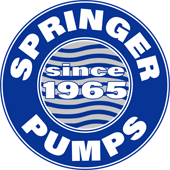 Springer Pumps, LLC.
Springer Pumps, LLC.Mailing: PO Box 269, Telford, PA 18969
Shipping: 861 Tech Drive, Telford, PA 18969
Int'l: 267-404-2910
Toll Free: 866-777-6060
Toll Free Fax: 866-777-6383
Email: info@springerpumps.com
Website: www.springerpumps.com
 Springer Pumps, LLC.
Springer Pumps, LLC.The diaphragm provides the body seal as well as the seat seal. There are no paths to the outside environment and, as such, the valve is suitable for aseptic processes. When the valve is being closed, a pressure pad which supports the diaphragm moves towards the sealing face on the body. As the pressure plate moves, the diaphragm flexes and is forced down onto the seat area in the center of the body, thus, closing off the flow path through the body. The inter-relationship of body to the pressure plate prevents over-compression of the diaphragm.
The valve can be actuated either manually or pneumatically and controlled by control tops and solenoid valves.
Straight through the flow path. High Kv factor.
Controlled compression of sealing.
Compact actuator.
Normally closed (NC) pneumatic actuator (standard).
Sealed actuator with no maintenance required (stainless steel version).
Handle with stroke limiter (except size Nº4).
Leak detector.
Position indicator.
Interchangeability of parts.
Ergonomic handle.
Traceability of components.
Parts in contact with the product Stainless steel AISI 316L (1.4404)
Other stainless steel parts Stainless steel AISI 304 (1.4301)
Plastic parts PP + 30 GF
Diaphragm EPDM (according to FDA 177.2600 and USP Class VI)
Surface finish:
Internal Ra ≤ 0,5 µm
External Bright polish
Available sizes DN ¼" - DN 2"
Connections Weld and Clamp OD / DIN
Diaphragm: FPM, VMQ (according to FDA 177.2600 and USP Class VI) and PTFE / EPDM separate (according to FDA 177.2600).
Manual or pneumatic actuation.
Handle: stainless steel or plastic.
Bonnet: stainless steel or plastic.
Normally open (NO) double-acting pneumatic actuator.
Pneumatic actuator with stroke limiter.
Pneumatic actuator with external switch.
Control box with switches and solenoid valves.
Valve with controller and positioner.
Tank bottom valve.
Various types of connections.
Materials and roughness certificates.